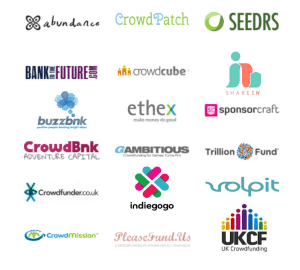Fresh from my trip across the pond, I can tell you I have seen the light. Crowdfunding can and is working and we (the United States) are behind the eight ball on this one. When describing the US regulatory regime to crowdfunding professionals in the UK I would first encounter shock (that the UK system could possibly be more efficient and advanced than the US structure) and then pride (that the UK system was more efficient and advanced than the US structure). It wasn’t the most fun conversation.
Feelings aside, the truth remains that the Brits are getting it right.
 Crowdcube, the UK’s first equity crowdfunding portal has been in operation for three years now and has successfully raised over £20 million for over 100 companies.
Crowdcube, the UK’s first equity crowdfunding portal has been in operation for three years now and has successfully raised over £20 million for over 100 companies.
Another huge component of the UK crowdfunding landscape is the peer to peer (P2P) lending market which has blossomed and, unlike the US market, does NOT require a full blown registration statement to offer to retail investors. P2P lending is a bit of a loose term as it is currently being used to describe both crowdsourced loans to individuals and crowdsourced loans to businesses (P2B).
The enlightened approach taken by the Financial Conduct Authority (FCA), formerly the Financial Services Authority, (note: I do not think I have ever described a regulatory body as enlightened before) was to allow a market to develop without regulating the life out of it and then to determine some reasonable parameters to ensure safety and soundness.
The first huge distinction between the US and UK markets are the ways that debt and equity are treated.
In the US, both debt and equity securities are lumped together into the same regulatory wheelhouse of the Securities and Exchange Commission (SEC). In the UK, however, corporate debt (as opposed to equity) is lightly regulated. Equity, understandably as the riskier part of the capital structure, is more closely scrutinized.
This reduced burden on debt securities has allowed the UK P2P market to flourish, raising an estimated £480 million in 2013 (P2P – £287 Million & P2B – £193 Million) last year alone.
In the US we have Prosper (a true P2P site but the loan proceeds can be used to fund a business) and Lending Club (mostly P2P but moving into the P2B space) which collectively have funded over $4.5 billion in loans, however, both platforms have had to file registration statements with the SEC in order to conduct their offerings which adds time and expense to the process and may not be sustainable or scalable.
 The equity crowdfunding market, due to the higher level of scrutiny, has matured more slowly and can be thought of as targeting investors somewhere between a US “accredited investor” and a retail investor. Similar to the US a pure retail inexperienced investor cannot participate in crowdfunding. However, a person with a reasonable amount of sophistication, that can affirm such knowledge and understanding by taking an online exam or attest in other ways, may participate in an equity crowdfunding offering.
The equity crowdfunding market, due to the higher level of scrutiny, has matured more slowly and can be thought of as targeting investors somewhere between a US “accredited investor” and a retail investor. Similar to the US a pure retail inexperienced investor cannot participate in crowdfunding. However, a person with a reasonable amount of sophistication, that can affirm such knowledge and understanding by taking an online exam or attest in other ways, may participate in an equity crowdfunding offering.
Additionally, due to new regulations by the FCA, an individual investor may not invest more than 10% of his or her investable assets (which does not include equity in one’s primary residence) into equity crowdfunding ventures. These standards, while beneficial in ensuring the aptitude of potential investors, are certainly less burdensome than the accredited investor standard and the “reasonable steps” required to affirm investor accreditation of Rule 506(c), as promulgated by the SEC.
Although the regulatory train may have already left the station in the US, below are some of the crucial components of the UK crowdfunding framework that regulators and frankly anyone who cares about the future of crowdfunding should take note of and work to achieve.
Curation
 First and foremost curation is essential, as both a fraud deterrent and a way to maintain brand quality for a funding platform.
First and foremost curation is essential, as both a fraud deterrent and a way to maintain brand quality for a funding platform.
In a lending/debt sense it is called underwriting and you would not consider providing a loan without doing it. The same goes for the equity side. Both of the leading equity crowdfunding platforms in the UK intensely vet the companies they list on their site, on both a quantitative and qualitative basis. This is an essential part of their business model and directly correlated to the low incidence of fraud (0%) on their sites. This is an area that the SEC plainly got wrong. In the proposed crowdfunding regulations the SEC has prohibited funding portals from subjectively selecting which companies to list on its platform, requiring them to onboard any company regardless of the viability of its business model or potential for success. This has needlessly removed a major tool in investor protection that is working with great success in the UK.
Tax Incentive
With the Brits it always comes down to taxes and in this case, they got it right.
 Through the Enterprise Investment Scheme (EIS) and the Seed Enterprise Investment Scheme (SEIS) investors can deduct 50% (or more) of certain qualified (crowdfunding) investments from their annual income tax, pay no capital gains on any appreciation and if the business fails they can deduct a portion or all of their investment. This structure is ingenious and has been a significant boost to the crowdfunding industry. By incentivizing investment in small businesses by average individuals, the government has found a way to help finance businesses, create jobs, increase a sense of community and financial education, diversify citizen’s investment portfolios and protect investors in one stroke of a pen. The US should consider following by example or crowdfunding will not be the only economic metric in which the UK is leading.
Through the Enterprise Investment Scheme (EIS) and the Seed Enterprise Investment Scheme (SEIS) investors can deduct 50% (or more) of certain qualified (crowdfunding) investments from their annual income tax, pay no capital gains on any appreciation and if the business fails they can deduct a portion or all of their investment. This structure is ingenious and has been a significant boost to the crowdfunding industry. By incentivizing investment in small businesses by average individuals, the government has found a way to help finance businesses, create jobs, increase a sense of community and financial education, diversify citizen’s investment portfolios and protect investors in one stroke of a pen. The US should consider following by example or crowdfunding will not be the only economic metric in which the UK is leading.
No caps
In the UK there are no caps on the amount of money that can be raised nor are there caps on the amount an individual investor can contribute (other than the 10% of investable assets rule).
In the US under the proposed retail crowdfunding regulations, the company may only raise $1,00,000 in any twelve month period and investors may only invest the greater of $5,000 and 2% of their income if their income is less than $100,000 per year and then 10% of their income if they make over $100,000. Regardless of income or sophistication level the investment amount is capped at $100,000. In the UK this is not so and by simply providing the 10% of investible assets guideline, they allow the market to determine the amount of money raised and invested rather than setting arbitrary limits.
Disclosure – fair, clear and not misleading
Rather than setting forth hundreds of pages of instructions and requirements dictating the disclosures that must be provided to investors, the UK simply requires the disclosure information to be “fair, clear and not misleading.”
This is similar to the US anti-fraud baseline, which requires that information provided in connection with offer or sale of a security not contain any “material misstatements or omissions.” Importantly, it is the fear of “omissions,” which is notably not a part of the UK standard, that all too often leads to indecipherable offering documents that are hundreds of pages long. Additionally, the mandated disclosures set forth in Regulation S-K and now Regulation CF are overly burdensome and provide little value to an investor.
 It is a real problem in the US that so much time and energy is spent on preparing offering documentation that will never be read and thus does not serve the intended purpose of informing and educating the investor. Such documentation is not required in the UK and it is up to the company and its advisors to determine the level of information to provide to potential investors (including financial information).
It is a real problem in the US that so much time and energy is spent on preparing offering documentation that will never be read and thus does not serve the intended purpose of informing and educating the investor. Such documentation is not required in the UK and it is up to the company and its advisors to determine the level of information to provide to potential investors (including financial information).
In the UK, due to the diligence and vetting process of the crowdfunding platforms and their assistance in preparing the offering memorandum and investor package, a nice balance is struck between efficient offering procedures and ensuring an investor can make an informed choice.
Investment Funds
 In the UK, crowdfunding platforms can aggregate companies on their sites and offer a pool of companies to spread the risk and give an investor access to multiple companies at a low investment threshold. This is also helpful in aggregating a community of businesses, which are in need of capital and may even be in a blighted area. It also allows investors interested in a particular industry sector to get exposure to many companies in that area. An example of this is Seedrs’ Webstart Bristol fund, which combines both the local nexus of the city of Bristol and the tech sector and allows investors to invest across 10 tech startups in its incubator program.
In the UK, crowdfunding platforms can aggregate companies on their sites and offer a pool of companies to spread the risk and give an investor access to multiple companies at a low investment threshold. This is also helpful in aggregating a community of businesses, which are in need of capital and may even be in a blighted area. It also allows investors interested in a particular industry sector to get exposure to many companies in that area. An example of this is Seedrs’ Webstart Bristol fund, which combines both the local nexus of the city of Bristol and the tech sector and allows investors to invest across 10 tech startups in its incubator program.
In the US this is not permissible, as such a fund would be considered an “investment company” under the Investment Company Act of 1940 and aside from some potentially available exemptions would require the fund to be registered and regulated by the SEC, which is a very onerous process and not sustainable for the small investments contemplated by the crowdfunding model.
Secondary market
One point of contention stems from the development or need for a secondary market for crowdfunded securities.
From a debt instrument perspective, it seems natural for a secondary market to develop as people can sell or buy an instrument with a knowable risk profile and terms such as interest rate and payment schedule. This is currently being offered on many of the UK P2P sites for their investors.
From an equity standpoint, opinions are mixed as to whether a secondary market is the best thing for the industry.
 Goncalo de Vasconcelos of Syndicate Room seemed to think it was inevitable at the Great British Private Investors Summit, while Karen Kerrigan of Seedrs explained that we should exercise caution when developing a secondary market because it can cause people to view investments with a short term mentality and that small and start up businesses require more patient capital and a longer time horizon. She also noted that a secondary market creates extra volatility for a start up company that it may not be prepared to handle. Importantly, in order to maintain the EIS and SEIS tax benefits, the securities must be held for at least three years, which will likely limit a secondary market from developing.
Goncalo de Vasconcelos of Syndicate Room seemed to think it was inevitable at the Great British Private Investors Summit, while Karen Kerrigan of Seedrs explained that we should exercise caution when developing a secondary market because it can cause people to view investments with a short term mentality and that small and start up businesses require more patient capital and a longer time horizon. She also noted that a secondary market creates extra volatility for a start up company that it may not be prepared to handle. Importantly, in order to maintain the EIS and SEIS tax benefits, the securities must be held for at least three years, which will likely limit a secondary market from developing.
On the debt side in the US, Prosper and Lending Club offer liquidity by way of an internal trading platform for its members. In the US we do not have a secondary market for equity crowdfunded securities.
 Because at this stage, other than a very few exceptions, all the equity securities issued via crowdfunding in the US have been done so under an exemption from registration, the securities are not freely tradable and require an exemption for the secondary transfer. Any secondary market that develops would have to comply with the private placement rules which makes the process more difficult but not insurmountable. Additionally under the proposed crowdfunding regulations by the SEC, funding portals are prohibited from offering a secondary market to the investors on its site, so the entity in one of the most efficient positions to create a secondary market will be unable to do so. In this area we have a good opportunity to watch and see how our brethren across the pond address this situation and to take a page out of their playbook at least when it comes to the P2P securities.
Because at this stage, other than a very few exceptions, all the equity securities issued via crowdfunding in the US have been done so under an exemption from registration, the securities are not freely tradable and require an exemption for the secondary transfer. Any secondary market that develops would have to comply with the private placement rules which makes the process more difficult but not insurmountable. Additionally under the proposed crowdfunding regulations by the SEC, funding portals are prohibited from offering a secondary market to the investors on its site, so the entity in one of the most efficient positions to create a secondary market will be unable to do so. In this area we have a good opportunity to watch and see how our brethren across the pond address this situation and to take a page out of their playbook at least when it comes to the P2P securities.
 The above factors are helping to create a sound and successful method for small and startup business to raise the essential capital they have been denied for too long. It is difficult to believe that our current regulatory structure in the US is prohibiting some of these factors, which are crucial to the success of the industry.
The above factors are helping to create a sound and successful method for small and startup business to raise the essential capital they have been denied for too long. It is difficult to believe that our current regulatory structure in the US is prohibiting some of these factors, which are crucial to the success of the industry.
There is no doubt we are lagging when it comes to the crowdfunding opportunity, unfortunately the current framework seems to be setting us up for failure.
I am a firm believer that crowdfunding is good for our economy as a whole and will eventually work, but a little help would be nice. Until that time we can continue to watch the Brits innovate and thrive while we fill out more paperwork.
____________________________________
 Georgia P. Quinn, a senior associate in Seyfarth Shaw LLP’s Corporate department, has spent her career representing public and private companies and investment banks in a wide range of capital markets transactions, including registered offerings and private placements of debt, equity, and hybrid securities. Over the last year, Ms. Quinn has led Seyfarth’s Crowdfunding Initiative, helping clients stay at the forefront of the enacted and proposed SEC regulations. Georgia has conducted webinars, presented to the New York State Bar Association’s Securities Law Section and the Business Law and International Sections, has been featured on Crowdfund Insider and has been invited to chair a panel on Crowdfunding for the American Bar Association in April. All views and comments above are strictly her own views and do not reflect the opinion or position of Seyfarth Shaw.
Georgia P. Quinn, a senior associate in Seyfarth Shaw LLP’s Corporate department, has spent her career representing public and private companies and investment banks in a wide range of capital markets transactions, including registered offerings and private placements of debt, equity, and hybrid securities. Over the last year, Ms. Quinn has led Seyfarth’s Crowdfunding Initiative, helping clients stay at the forefront of the enacted and proposed SEC regulations. Georgia has conducted webinars, presented to the New York State Bar Association’s Securities Law Section and the Business Law and International Sections, has been featured on Crowdfund Insider and has been invited to chair a panel on Crowdfunding for the American Bar Association in April. All views and comments above are strictly her own views and do not reflect the opinion or position of Seyfarth Shaw.


